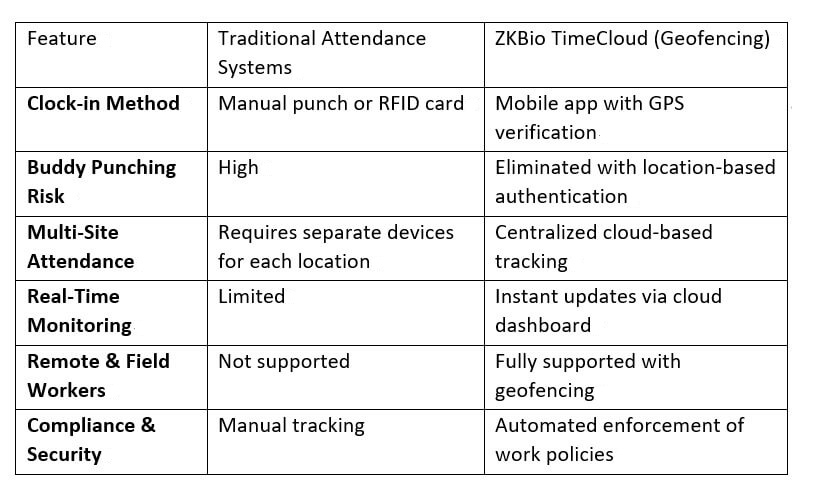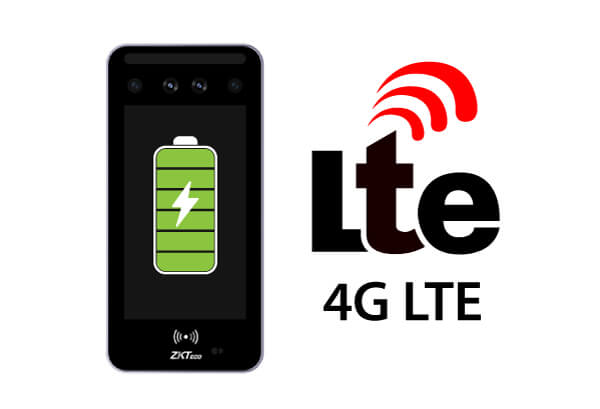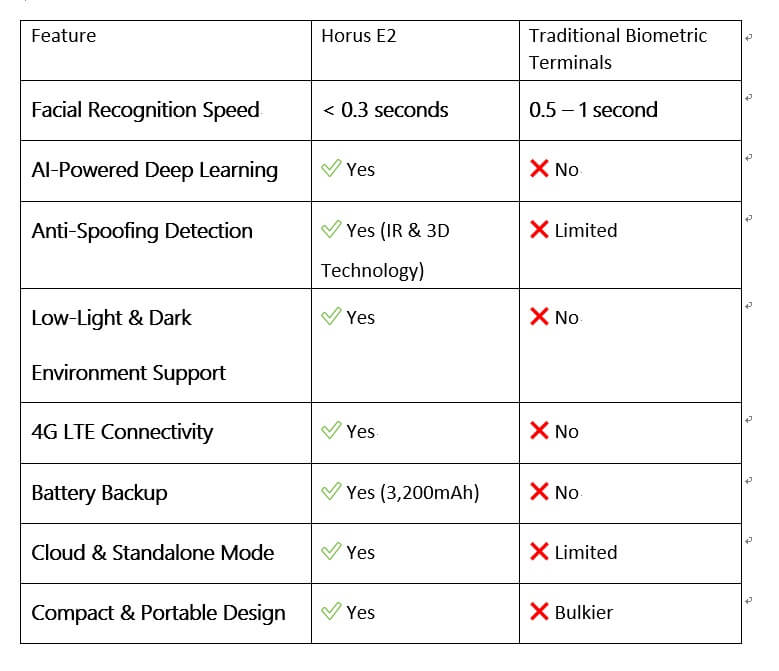ZKTeco recently announced two brand-new offerings: ZKBio TimeCloud, a cloud-based time and attendance software, and Horus E2, an Android-based multi-biometrics terminal designed to streamline time attendance and access control. This article takes a closer look at the solutions and how users can benefit from them.
ZKBio TimeCloud: Cost-effective, scalable and secure
ZKBio TimeCloud is a cloud-based time and attendance management software. It is accessible from anywhere via the user’s PC or mobile device and is fully optimized for ZKTeco’s next-generation biometrics terminals; examples include the SpeedFace-V5L Series, Horus E2 and the UFace Series.
Since ZKBio TimeCloud is cloud-based, it overcomes certain challenges seen in traditional time and attendance systems. Traditional on-premises solutions require significant equipment and IT maintenance cost, are less scalable and accessible, and carry security and compliance issues. Not so with ZKBio TimeCloud, which is a cloud-based SaaS solution hosted on Amazon Web Services (AWS) – this removes the need for on-premises servers and manual maintenance; businesses only pay a subscription fee, reducing upfront costs. ZKTeco, meanwhile, manages automatic software updates, security patches, and system upgrades, ensuring hassle-free operation.
ZKBio TimeCloud is also highly scalable, making it suitable for growing enterprises and multi-location businesses. Last but not least, ZKBio TimeCloud is secure and compliance-ready, with its AWS-backed infrastructure guaranteeing high availability, disaster recovery, and data protection.
Cutting-edge features
ZKBio TimeCloud is designed to solve real-world time attendance and workforce management issues. It comes with the following advanced time and attendance features:
- Seamless integration with Ralvie AI for workforce analytics: One of ZKBio TimeCloud’s standout features is its deep integration with the Ralvie AI platform, an AI productivity and workflow optimization tool. Ralvie AI can reduce HR workload by allowing them to perform real-time employee performance monitoring, get detailed reports on employee efficiency and project timelines, and synchronize attendance data with project management tools;
- Flexible attendance policies and multi-site management: ZKBio TimeCloud supports customizable attendance rules, making it ideal for businesses with complex workforce structures;
- Multi-level approval workflows and automated notifications: ZKBio TimeCloud simplifies HR management by automating approvals for leave requests, schedule changes, and manual punches;
- Comprehensive reporting and compliance management: 30-plus built-in reports for HR analytics, payroll processing, and compliance tracking are supported and can be automatically exported in PDF, Excel, CSV, and TXT formats.
It’s especially worth-mentioning that ZKBio TimeCloud supports geofencing and GPS-based employee tracking, which addresses time theft, buddy punching and other workforce fraudulent issues. Some employees, for example, manipulate attendance records by clocking in remotely or asking colleagues to punch in for them. Some employees may claim they are working in the field when they are not actually at the assigned location. By leveraging GPS and geofencing technology, the Geofencing Mobile Punch feature enables businesses to define specific geographic zones where employees are allowed to clock in, thus improving attendance accuracy for field workers, remote employees, and multi-site businesses.
“Traditional time tracking systems rely on manual clock-ins or IP-based restrictions, which are easily bypassed. ZKBio TimeCloud’s GPS-based geofencing ensures attendance data accuracy,” said Garrett Li, Senior Solutions Manager at ZKTeco. “With ZKBio TimeCloud, businesses can define geofenced attendance zones, ensuring employees only check in from authorized locations. This can prevent time fraud as the system restricts employees from clocking in outside designated areas. Workforce productivity can also be enhanced, as field workers, sales teams, and remote employees checking in from assigned locations is ensured.”
ZKBio TimeCloud vs. Traditional Systems

Who can benefit
ZKBio TimeCloud is designed for businesses of all sizes but is particularly suitable for SMEs and multi-site organizations. Small and medium businesses typically lack dedicated IT teams or infrastructure to manage traditional attendance systems. ZKBio TimeCloud, on the other hand, enables quick deployment with minimal setup and can be accessed from any device. This makes ZKBio TimeCloud ideal for SMEs such as retail shops, boutiques, small offices, startups and fitness centers.
ZKBio TimeCloud is also well-suited for multi-site companies which often struggle with consolidating attendance data across different locations. That said, ZKBio TimeCloud’s cross-location unified attendance tracking capability, customizable shift configurations for each branch and real-time reporting for payroll processing and compliance can satisfy the workforce management needs of multi-site companies such as restaurant and coffee shop chains, convenience stores, gas stations and business process outsourcing (BPO) firms.
Other verticals that can benefit from ZKBio TimeCloud include: service and field-based industries, manufacturing and industrial sectors, healthcare and hospitality sectors, and educational and government sectors.
Horus E2: Streamlining time attendance and access control
Horus E2 is an Android-based multi-biometrics terminal. It is designed to streamline both time attendance and access control. The terminal stands out due to its multiple authentication support, third-party applications integrations and extended mobile usage, making it one of the most advanced biometric terminals in the market.
Horus E2 enables different types of authentication for access control and time attendance. These include facial recognition, fingerprint, RFID and QR code. Horus E2 features the latest facial recognition technology that enables ultra-fast authentication, high security, and lowlight and infrared detection.
Extended mobile usage
Yet it’s Horus E2’s extended mobile usage that makes the terminal truly stand out. The terminal supports 4G LTE connectivity in addition to Wi-Fi and Ethernet, making it ideal for locations without wired Internet. Additionally, Horus E2 includes an optional removable 3,200mAh lithium backup battery that enhances the terminal’s reliability and allows it to operate without a continuous power supply. Finally, unlike bulky biometric systems, Horus E2 is compact and designed for versatility and portability. It is ultra-slim, lightweight and easily mounted on walls, gates, or turnstiles. It can be fixed, portable, or used with tripods.

These features make Horus E2 especially suitable for sites or scenarios that are temporary in nature. Examples include construction companies and infrastructure projects, which are often temporary and lack stable power or Internet connections. Horus E2’s battery backup and 4G LTE connectivity enable workers to clock in from remote locations without requiring wired power. Also, oil and gas, mining and industrial sites can benefit as well. These sites are often in remote or hazardous locations where traditional biometric terminals are impractical. In this regard, Horus E2’s battery-powered operation and 4G LTE support allow workers in oil rigs, refineries, and mines to authenticate via biometric verification, while enabling companies to track workforce attendance and restrict unauthorized access.
Other sites or parties that can bene‑t from Horus E2 include event management venues, disaster relief and emergency response teams, and law enforcement checkpoints.
Integration with 3rd-party applications
Finally, Horus E2 is deeply customized based on the Android 10 operating system and supports the Android Low Code Development Platform (LCDP) for third-party applications integrations. “To streamline third-party integration, we have developed a LCDP platform for system integrators. This platform unifies and encapsulates algorithm interfaces through a standardized SDK; supports rapid integration of biometric authentication methods such as face recognition and fingerprint verification; reduces biometric module development time by over 60 percent; and significantly shortens the product delivery cycle, improving efficiency,” said Paul Yang, Senior Product Manager at ZKTeco.
How Horus E2 differentiates from other biometric terminals

Conclusion
Time and attendance is one of the most important functions of a company. In this regard, ZKTeco has rolled out ZKBio TimeCloud and Horus E2 to meet users’ increasingly complex time and attendance needs. With ZKBio TimeCloud and Horus E2, companies can see their workforce management efficiency boosted, while employees can clock in and out with ease, no matter where they are.
Official Website: ZKTeco
Product Info: Horus E2